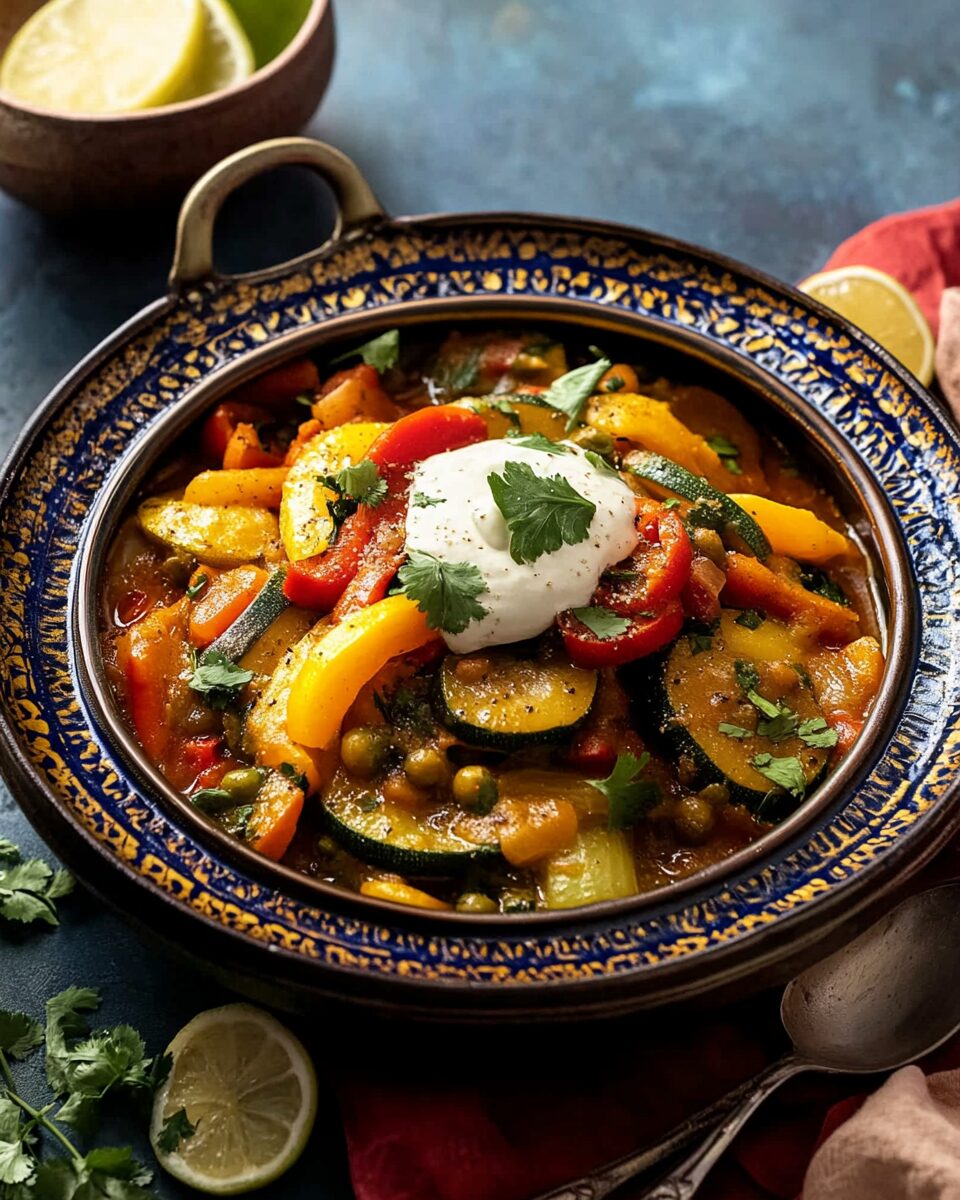This Moroccan Vegetable Tagine is a hearty stew that brings together an abundance of flavors from warm spices like cumin, turmeric, and cardamom, mixed with tender seasonal vegetables. Pan-roasting the veggies before simmering allows them to develop deep flavors, creating a comforting and fragrant dish.
Perfect for both weeknight meals and special occasions, the Vegetable Tagine is not only delicious but also versatile. Serve it traditionally with couscous, as a chunky stew, or paired with quinoa or rice. The addition of fresh lemon juice and zest adds a bright, zesty finish to the rich, aromatic broth, making each bite a true celebration of flavor.
Full Recipe:
Tagine Spice Mix:
- 1 tbsp cardamom powder
- 1 tbsp coriander powder
- 1 tbsp cumin powder
- 1 1/2 tsp ground fennel seeds / fennel powder
- 1 tsp cayenne (omit for non-spicy)
- 2 tsp turmeric
- 1/4 tsp ground cloves
- 1/4 tsp ground ginger
Tagine:
- 5 tbsp olive oil
- 1/2 red onion, sliced (substitute any type of onion)
- 1 garlic clove, finely minced
- 800g/1.6lb butternut pumpkin/squash (1/2 a small), peeled, cut into 2.5cm / 1″ cubes
- 1 small eggplant, cut into 2.5cm / 1″ cubes
- 1/2 cauliflower head, small, cut into bite-size florets
- 1 capsicum/bell pepper, cut into 2.5cm / 1″ pieces (red or yellow)
- 2 tomatoes, seeds removed, cut into 1cm / 1/3″ dice
- 3 1/2 cups water
- 2 tsp salt
- 1/2 tsp black pepper
- 400g/14oz canned chickpeas, drained
- 200g/6oz green beans, cut into 3.5cm / 1.5″ pieces (~2 cups cut)
- Zest of 1 lemon
- 2 tbsp lemon juice
Garnishes/For Serving:
- 1/2 cup slivered almonds, toasted
- 1/4 cup coriander/cilantro, roughly chopped
- Plain yogurt
- Pinch of paprika or cayenne pepper
Directions:
- Preheat oven to 180°C/350°F.
- Combine all the Tagine Spice Mix ingredients and set aside.
- Heat 1 tbsp olive oil in a large, heavy-based pot over medium-high heat. Add garlic and onion, cook until the onion is softened (~1 1/2 minutes), then remove to a large bowl.
- Add pumpkin/squash to the pot with an additional 1 tbsp of oil. Cook for 3 minutes or until lightly golden on most sides. Remove to the bowl with onion and garlic.
- Add 2 tbsp olive oil and cook eggplant for 3 minutes until tinged with gold on most sides. Remove to the bowl.
- Add 1 tbsp oil if the pot is dry. Add capsicum and cauliflower, cook for 2 minutes until cauliflower is golden on the edges. Remove to the bowl.
- Add tomato to the pot and cook for 1 minute. Add the spice mix, stir for 1 minute.
- Return all the vegetables to the pot. Add water (almost covering the vegetables), salt, and pepper. Bring to a simmer on the stove, then transfer to the oven for 30 minutes (or simmer on a low stove, stirring gently).
- Remove from oven, add green beans and chickpeas. Simmer for 15 minutes uncovered on the stove to cook the beans and reduce the sauce.
- Stir in lemon zest and juice. The soft-cooked pumpkin and cauliflower help naturally thicken the sauce.
- Serve with couscous, rice, or as a standalone stew. Top with garnishes as desired.
Prep Time: 15 minutes | Cooking Time: 45 minutes | Total Time: 1 hour
Kcal: 200 kcal per serving | Servings: 8-10 servings
Origins and Cultural Background of Tagine
The dish “Tagine” derives its name from the traditional North African earthenware pot in which it’s cooked. The conical shape of the pot allows steam to circulate, creating a self-basting environment that retains moisture and infuses the ingredients with flavor. While it originates from Morocco, variations of tagine can be found throughout North Africa, each region adding its unique touch to the dish.
Flavor Profile and Spice Mix
The Vegetable Tagine boasts a unique flavor profile thanks to a mix of warm spices: cardamom, cumin, coriander, turmeric, fennel, and ginger, with a touch of cayenne for those who prefer a bit of heat. Unlike the bold “kapow” of Indian curries, the tagine’s spices provide a warm, aromatic backdrop that enhances the natural sweetness of vegetables. The subtle fragrance of these spices makes the tagine both exotic and accessible, appealing to those who are new to Middle Eastern or Moroccan cuisine.
Nutritional Benefits
This Vegetable Tagine is not only delicious but packed with nutrients:
- High in Fiber: The mix of vegetables, chickpeas, and spices provides a healthy dose of dietary fiber, which supports digestive health and keeps you feeling full longer.
- Low-Calorie and Nutrient-Dense: Each serving is around 200 kcal, making it a great option for those looking for low-calorie, filling meals.
- Rich in Vitamins and Minerals: The variety of veggies brings a bounty of vitamins A, C, and potassium. The inclusion of lemon adds a burst of vitamin C, enhancing absorption of the iron from the chickpeas.
Serving and Pairing Suggestions
The Vegetable Tagine is versatile when it comes to serving options. It pairs beautifully with:
- Couscous: The traditional accompaniment; choose herbed couscous or a fruity nut version to add texture and a sweet touch.
- Rice: White, brown, or basmati rice offer a neutral base that soaks up the aromatic broth.
- Quinoa or Cauliflower Rice: Great gluten-free and low-carb alternatives.
- Flatbreads: Serve with pita, naan, or homemade flatbreads to scoop up the stew.
For a cooling contrast to the tagine’s spiced warmth, a dollop of plain yogurt or a vegan yogurt alternative can be added when serving. Garnish with slivered almonds for crunch, cilantro for freshness, and a pinch of cayenne for an extra kick.
Customization and Variations
The beauty of this dish lies in its flexibility. Feel free to mix and match vegetables based on what’s available and in season. Some possible swaps or additions include:
- Sweet Potato: A slightly sweeter and softer texture that breaks down to thicken the sauce.
- Zucchini: Adds a tender bite and cooks quickly.
- Carrots or Parsnips: For an earthy, sweet undertone.
- Olives: Green or black olives add a briny depth, aligning with the traditional flavors of Moroccan cooking.
If you’re not vegan or vegetarian, you can add meat like chicken thighs or lamb to the tagine. Season the meat with some of the spice mix, sear it before cooking the vegetables, and then follow the rest of the recipe.
Storage and Meal Prep Tips
This tagine keeps well and can even develop deeper flavors as it sits, making it perfect for meal prep:
- Fridge Storage: Store in an airtight container for up to 5 days. Reheat gently on the stove or microwave. A fresh squeeze of lemon juice before serving will brighten the flavors.
- Freezing: It can be frozen for up to 3 months. Thaw overnight in the fridge and reheat thoroughly before serving.
- Make Ahead: The spice mix can be prepared ahead of time and stored in an airtight container. You can also pre-chop the vegetables the day before for easy assembly.
Why You’ll Love This Recipe
- Easy One-Pot Cooking: Minimal cleanup and maximum flavor make this a stress-free meal for busy weeknights or leisurely weekend dinners.
- Dietary-Friendly: Naturally vegan, gluten-free, and low in carbs, this dish suits a variety of dietary needs.
- Flavorful and Filling: Thanks to the combination of warming spices and hearty vegetables, it’s a meal that’s both satisfying and nourishing.
Traditional and Modern Twist
While this recipe is a nod to traditional Moroccan cooking, it’s adapted for the modern kitchen. Instead of a tagine pot, a Dutch oven or heavy-based pot does the trick, retaining all the flavor and moisture.
Cooking Techniques
- Braising: This recipe employs a braising technique that allows the vegetables to cook slowly in a mix of spices and moisture. This process results in tender vegetables infused with deep flavors, creating a rich, hearty stew that becomes more delicious over time.
- Pan-Roasting: The method of pan-roasting the vegetables before combining them with the spices and liquid enhances their natural sweetness and develops a caramelized flavor, adding complexity to the dish.
Seasonal Variations
The Vegetable Tagine is an excellent dish for showcasing seasonal produce:
- Spring: Incorporate asparagus, artichokes, or peas to reflect the fresh greens of spring.
- Summer: Use zucchini, squash, or fresh tomatoes to celebrate the vibrant vegetables of summer.
- Fall: Sweet potatoes, carrots, and seasonal root vegetables can be used to add warmth and sweetness.
- Winter: Incorporate hearty greens like kale or Swiss chard, as well as root vegetables that thrive in colder months.
Flavor Enhancements
- Herbs: Fresh herbs like parsley or cilantro can be added just before serving for a burst of freshness. Dried herbs like thyme or oregano can also enhance the flavor profile.
- Spicy Variations: For those who enjoy a bit more heat, consider adding harissa, a North African chili paste, or red pepper flakes to spice things up.
- Fruits: Dried fruits like apricots or raisins can be added during cooking to introduce a sweet contrast to the savory spices, balancing the flavors beautifully.
Serving Suggestions
- Serving Presentation: For an appealing presentation, serve the Vegetable Tagine in the pot it was cooked in, garnished with toasted almonds and fresh herbs. Alternatively, serve individual portions in bowls with a sprinkle of fresh herbs on top.
- Accompaniments: Complement the dish with:
- Breads: Crusty bread or homemade flatbreads for scooping.
- Salads: A light salad of arugula with a lemon vinaigrette can provide a refreshing contrast to the rich stew.
- Pickles: Moroccan pickles or a simple cucumber salad can add a tangy contrast.
Cultural Significance
- Moroccan Cuisine: Tagine is an iconic symbol of Moroccan cuisine, known for its unique blend of spices and cooking techniques. The dish often embodies the spirit of communal eating, where families gather to enjoy meals together.
- Adaptation: While this Vegetable Tagine recipe adheres to traditional flavors, it’s also adaptable for various dietary preferences, making it a perfect option for gatherings with diverse guests.
Sustainability Note
Using seasonal and local vegetables not only enhances flavor but also supports sustainable eating practices. Encourage readers to visit local farmers’ markets to find fresh ingredients for this recipe.
Conclusion
This Moroccan Vegetable Tagine is more than just a meal; it’s a celebration of flavor, culture, and community. By making this dish, you’re not just cooking; you’re experiencing a taste of Morocco right in your kitchen. It’s perfect for those seeking a fulfilling, nutritious, and comforting meal, whether for everyday dinners or special occasions.






